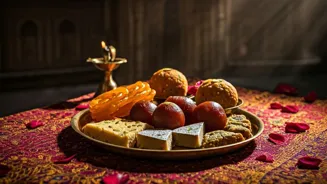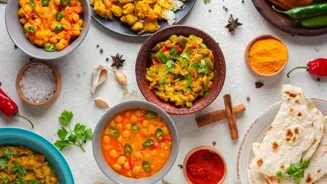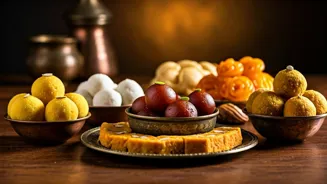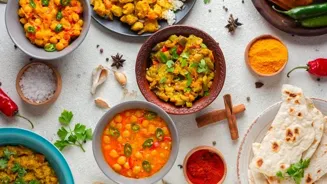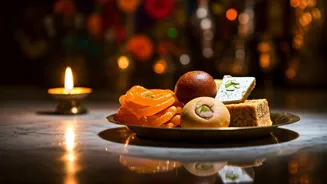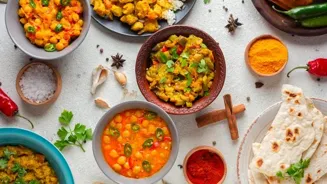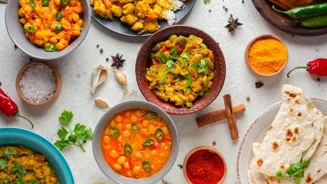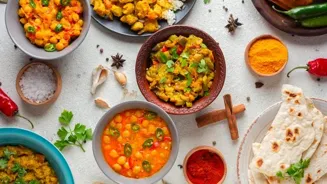Indulge in 5 Traditional Indian Desserts - a Sweet Symphony of Culture and Flavor. Read on to savor the essence of each treat!
Namaste, food lovers! We all know how tempting those mithai shops are, especially
during festivals. The aroma of ghee and sugar hangs heavy in the air, practically begging you to indulge. But sometimes, that little voice of guilt pops up, whispering about calories. Well, fret not!
Today, we're diving into five traditional Indian desserts that are so delicious, so culturally significant, and so soul-satisfying, that they are absolutely worth every single calorie.
We'll explore what makes them special, the ingredients they use, and maybe even a few interesting stories behind them. So, loosen your belts, grab a spoon, and let's get ready for a sweet ride. After all, life is too short to say no to good mithai!
Majestic Gulab Jamun: soft milk balls in fragrant syrup, a timeless classic dessert
First on our list is the majestic Gulab Jamun. These deep-fried milk balls, soaked in rose-flavored sugar syrup, are a staple at weddings, celebrations, and just about any happy occasion.
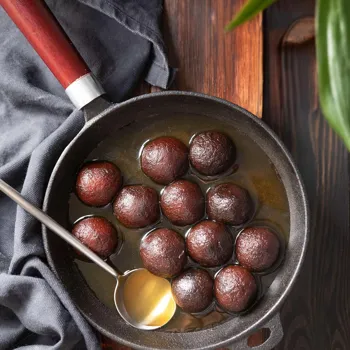
The magic of Gulab Jamun lies in its soft, melt-in-your-mouth texture and the fragrant syrup that bathes every inch. The traditional recipe involves khoya (reduced milk solids), paneer, and a touch of maida (all-purpose flour).
The dough is carefully kneaded and shaped into small balls, then deep-fried to a golden brown. The real star, however, is the sugar syrup, infused with cardamom, rosewater, and sometimes even saffron for that extra touch of luxury.
Gulab Jamun is believed to have originated in medieval Persia, later adopted and adapted by Indian chefs to create the version we know and love today. A good Gulab Jamun should be soft and spongy, not dense or chewy, and the syrup should be perfectly balanced – not too sweet, not too bland.
Whether enjoyed hot or cold, with a scoop of vanilla ice cream or simply on its own, Gulab Jamun is a timeless classic that will always have a special place in our hearts and on our dessert plates. So, go ahead, treat yourself, and let the sweetness transport you to a world of pure bliss.
Trust me, your taste buds will thank you for it.
Creamy Rasmalai: Bengali dessert with cheese patties in sweet milk, cardamom, pistachios
Next up, we have the creamy and decadent Rasmalai. This Bengali delight consists of flattened cheese patties soaked in thickened, sweetened milk, flavored with cardamom and pistachios. Rasmalai is essentially like a deconstructed cheesecake, but with an Indian twist.
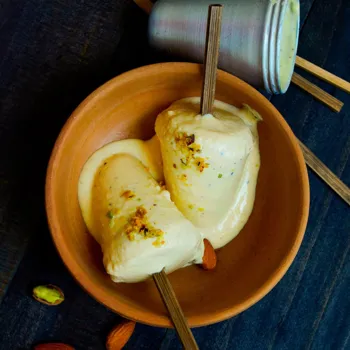
The cheese patties, known as rasgullas, are first cooked in sugar syrup until they puff up and become spongy. They are then gently squeezed to remove the excess syrup and immersed in a rich, creamy milk base called rabri.
The rabri is made by simmering milk for hours until it thickens and reduces, resulting in a concentrated flavor and a luxurious texture. Cardamom, saffron, and chopped pistachios add aromatic and textural complexity to the dish.
Rasmalai is often served chilled, making it a refreshing treat, especially during the hot summer months. The combination of the soft, spongy rasgullas and the rich, creamy rabri creates a symphony of flavors and textures that is simply irresistible.
Rasmalai is not just a dessert; it's an experience – a celebration of the rich culinary heritage of Bengal. Each bite is a reminder of the craftsmanship and dedication that goes into creating this iconic sweet.
Jalebi: Iconic Indian sweet treat, crispy outside, syrupy inside, enjoyed hot at festivals
Then, there's the ever-popular Jalebi. These crispy, pretzel-shaped treats, deep-fried and soaked in sugar syrup, are a quintessential Indian snack and dessert.
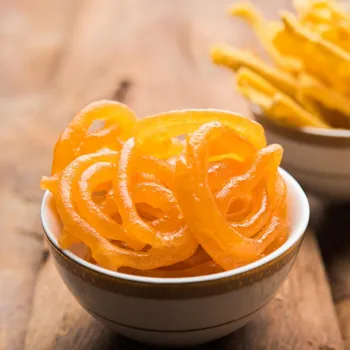
Jalebi is made from a fermented batter of maida (all-purpose flour) and besan (gram flour), which is piped into hot oil in swirling patterns. The jalebis are fried until golden brown and crispy, then immediately dunked in a warm sugar syrup infused with saffron and cardamom.
The result is a delightful combination of textures – crispy on the outside and syrupy on the inside. Jalebi is often enjoyed hot, straight from the frying pan, and is especially popular during festivals and fairs. It's also a common street food, sold by vendors across the country.
The origins of Jalebi are believed to be in the Middle East, where it is known as Zulabiya or Zalabia. It was introduced to India during the medieval period and has since become an integral part of Indian cuisine. Jalebi is often paired with rabri or curd for a more decadent treat.
The tangy-sweet combination is simply divine. The next time you're craving something sweet and satisfying, grab a plate of hot Jalebis. They are sure to put a smile on your face.
Rich, aromatic Gajar ka Halwa, a comforting winter dessert made with carrots, ghee, sugar, and nuts
Our fourth contender is the rich and aromatic Gajar ka Halwa. This carrot-based dessert is a winter favorite, made with grated carrots, ghee, sugar, and nuts. Gajar ka Halwa is a warm, comforting dessert that is perfect for chilly evenings.
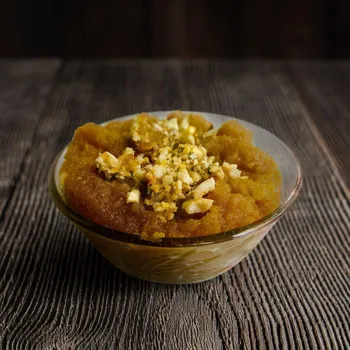
The grated carrots are slow-cooked in ghee until they soften and release their natural sweetness. Sugar is then added, along with cardamom and nuts such as almonds and cashews. The halwa is cooked until the moisture evaporates and the mixture thickens, resulting in a rich, caramelized flavor.
Gajar ka Halwa is often garnished with silver leaf (varak) for a touch of elegance. This dessert is not only delicious but also nutritious, as carrots are a good source of vitamins and fiber.
Gajar ka Halwa is a classic example of how simple ingredients can be transformed into something truly special. It's a reminder of the traditions that have been passed down through generations. So, cozy up with a bowl of Gajar ka Halwa and let its warmth embrace you.
It's a perfect way to end a meal or simply to indulge in a sweet treat.
Kheer: A Versatile Indian Rice Pudding Delight
Finally, we have the simple yet satisfying Kheer. This rice pudding, made with rice, milk, sugar, and flavored with cardamom and nuts, is a staple in Indian households. Kheer is a versatile dessert that can be made with various types of rice, including basmati and short-grain rice.
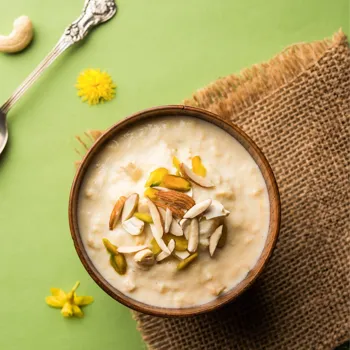
The rice is cooked in milk until it softens and thickens, creating a creamy and comforting pudding. Sugar is added to sweeten the kheer, and cardamom, saffron, and nuts are used to enhance the flavor.
Kheer is often served during festivals and celebrations, and it is considered to be an auspicious dessert. It is also a popular offering to deities in temples. There are many variations of Kheer, depending on the region and personal preferences.
Some people add dried fruits, such as raisins and apricots, while others add kewra water or rosewater for a more fragrant flavor. Kheer is a simple yet elegant dessert that is sure to please everyone. The creamy texture and subtle sweetness make it a perfect ending to any meal.
It's a reminder of the simple joys of life and the importance of cherishing traditions.
AI Generated Content. Glance/InMobi shall have no liability for the content
